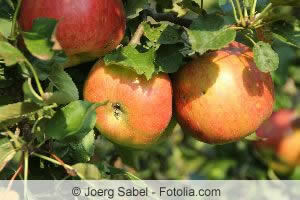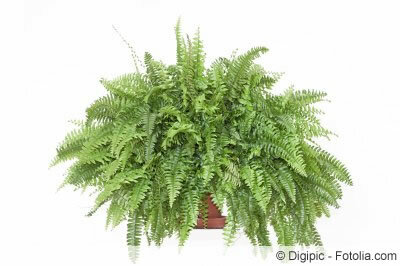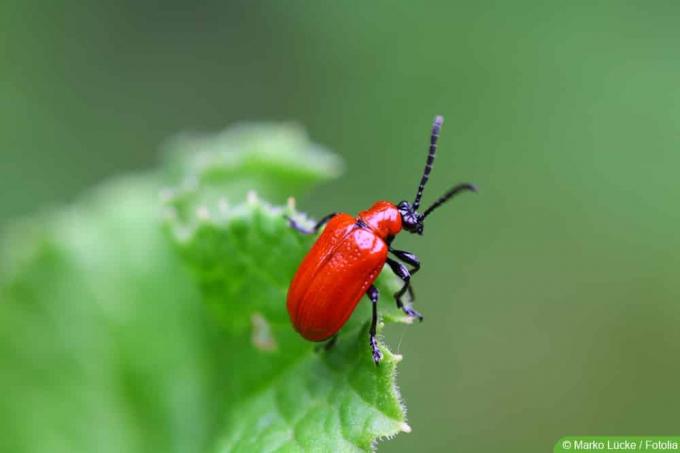

Table of contents
- Behavior and characteristics of blood lice
- Characteristic damage
- mechanical means
- biological control
- Extract and tea of bracken or male fern
- Bitterwood spray mixture (Quassia amara)
- Use beneficial insects against blood louse
- settle beneficial insects
- prevention and control
- Conclusion
Blood lice, a subspecies of aphids, are not native to Europe. It didn't come until the end of the 18th century. Century from North America to Central Europe. Its name comes from the fact that it gives off a red liquid when crushed. It prefers to attack apple trees and is therefore a widespread pest in apple orchards and gardens. There are a variety of methods to combat blood lice and their breeding populations. We give you an overview of the control measures as well as tips and tricks for the application.
Behavior and characteristics of blood lice
The blood louse (lat. Eriosoma lanigerum) overwinters on the root neck of apple trees as a grey-brown larva and likes to appear in the garden in sheltered locations. It nests mainly in wounds and cracks in the bark. However, it can also survive the winter in the ground. Some specimens even sit at a depth of 50 cm. In spring, the blood lice migrate to the apple tree crowns. There they form a white layer of wax around their bodies, which protects them from unwelcome weather conditions and even from pesticides. As soon as the winged offspring develop in summer, they quickly infest the surrounding woods and trees. Trellis fruit can also be infested, as well as mountain ash, rock medlar (cotoneaster) and ornamental quince.
Characteristic damage
In addition to the white, woolly populations, the cancerous growths on the apple trees, especially on the young shoots, are very characteristic of the infestation with blood lice. These growths are called canker sores. They are formed as a reaction of the fruit trees to the sucking activity of blood aphids, which can also be carriers of viral diseases such as apple cravings. In addition, the trees are polluted by the sticky excrements of blood lice.
mechanical means
The blood lice colonies can be brushed off or rinsed with water. It is best to rinse off the blood lice with a strong jet of water. Large cankers in the wood are cut out and sealed with tree wax.
biological control

Basically, blood lice are difficult to combat with pesticides, as they cannot or hardly penetrate through the white cotton wool. Here, however, persistence pays off with biological means.
Extract and tea of bracken or male fern
Worm fern and bracken contain small amounts of some toxic substances such as phloroglucin derivatives, certain bitter substances, tannins and oils. At normal doses, the toxins are harmless to pets and humans.
fern extract
Crush 10 g of leaves and put them in a bottle with 1 liter of rainwater. This is corked and must now steep for three days. The extract is then filtered off and sprayed undiluted onto the brushed off herds of blood lice. After that, repeat the procedure every three days.
Tip:
To improve the effect of the extract, you can add crushed green walnut shells or horse chestnuts to the base. The fern extract spray can also be used preventively in winter.
Fern tea:
For the fern tea, 1 kg of fresh or 150 g of dried fern leaves with 1 l of water are left to stand for a day and then boiled for 30 minutes. After cooling, the tea is diluted 1:10 and sprayed or brushed onto blood louse nests. The brushed off blood louse nests must be really dripping wet.
Nasturtium tea:
Pour 10 l of boiling water over 2 kg of fresh nasturtium herb and let it cook for approx. Leave covered for 15 minutes. After it has cooled, filter off and spray the blood lice and canker sores on the apple trees undiluted.
Pressed juice of the nasturtium:
Squeeze or squeeze fresh nasturtium herb. The resulting press juice is brushed onto the blood lice and canker sores.
Neem Oil Blend
If you have a very bad infestation with blood lice, you can also try neem oil, which is non-toxic to mammals and humans. The ingredients in neem oil prevent the reproduction of the sucking harmful insects, while beneficial insects remain unharmed. The neem oil is mixed with water and an emulsifier called Rimulgan. This is a natural emulsifier made from neem oil. Rimulgan and neem oil are commercially available.
- 1 ml Rimulgan
- 1 ml neem oil
- 500ml of water
- put everything in an atomizer
- shake well
- Brush or spray the solution on the lice
Bitterwood spray mixture (Quassia amara)

Wood chips from the Brazilian quassia tree can also be used against sucking insect pests such as blood lice. For a spray mixture, 150 to 250 g bitter wood shavings (commercially available) are mixed with 2 l water and left to stand for 24 hours. Then the solution is boiled for half an hour. This broth is prepared with approx. Diluted in 10 to 20 liters of water. It lasts approx. 4 to 6 months. The wood chips themselves can be dried again after cooking. This means that they can be used for two to three other applications. According to experts, Quassia is harmless to bees and also has no side effects for predatory mites, ladybugs and lacewings. Spray the affected areas on the apple tree sparingly. As soon as a coating forms after two to three days, clean the branches with clear water or horsetail broth.
Tip:
Always remember to brush the blood lice colonies off the infested branches before spraying. And always use broths, extracts, and teas with care. No beneficial insects should be affected.
Use beneficial insects against blood louse
The best conditions for keeping blood lice populations at a low level is an intact beneficial fauna, but this is not always the case. You should therefore try to lure the predators of blood lice into your garden, especially blood lice wasps, earwigs, ladybirds and larvae of lacewings and hoverflies.
blood aphid wasp:
The blood aphid wasp (Aphelinus mali) belongs to the so-called parasitic wasps. It was brought to Europe from North America at the beginning of the 20th century. Introduced in the 19th century to curb blood lice. It is still used today as a predator of blood lice in organic fruit growing. It is very small, only 0.7 to 1 mm in size. It has a black body and yellow hind legs and antennae. This tiny wasp lives near blood aphid colonies. The females lay their eggs inside the blood lice, allowing the larvae to feed on the lice and develop inside them until they hatch as an adult wasp. All stages of blood lice are attacked. The infested lice can be recognized by their black body, which is no longer covered with waxy wool.
settle beneficial insects
In order to settle other beneficial insects such as ladybugs, lacewings and earwigs, you can build protective insect hotels, remove dead wood or hedge and tree clippings in designated spots in your garden and a few faded stems of perennials and summer flowers in the fall permit. You can also support the settlement of beneficial insects with a piece of hardwood in which you drill holes of different lengths. Hang the wood in a warm and sheltered place in your garden. Even small ponds and natural ponds bring biodiversity and a natural balance to your garden.
prevention and control
As a preventive measure, you can attach glue rings to the trunk of the trees to prevent the lice from migrating up from the ground into the crowns in spring.
Check the affected branches regularly and spray or brush as needed.
Conclusion
Getting rid of blood lice from apple trees is not so easy, although there are many ways to do it. Their woolly waxy layer protects them. However, you can stop them with constant brushing and spraying with organic plant broths and teas. And the beneficial insects will help you if you leave them in your garden or lure them into it.
 garden editorial
garden editorial I write about everything that interests me in my garden.
Learn more about plant pests

White spots on leaves: what to do?
Whether in the home or in the garden, white spots on the leaves of your favorite plants are always a cause for concern. However, the causes can often be eliminated quickly. This guide summarizes the most common triggers and gives tips for quick help.

Cherry laurel has yellow eaten leaves: what to do?
Despite the robust nature of Prunus laurocerasus, it is occasionally attacked by pests and fungi. An infestation can be recognized by feeding damage and the discoloration of the leaves to yellow. You can find out how to combat and prevent the accumulation here.

Fighting grubs | Protect raised bed & lawn
Larvae of various species of beetles, grubs, can do a lot of damage in the garden. They live in the ground for several years and prefer to feed on roots. We present effective methods to combat the voracious pest or to effectively prevent an infestation.

Worms in cherries - 8 tips against maggots in cherries?
Worms in sweet cherries can spoil your appetite. It is a major nuisance when the entire cherry crop is affected. With these tricks you can contain the pest infestation and ensure that the insects do not multiply any further.

Fighting lily beetle - 11 effective home remedies
Lilies in the garden are beautiful to look at. There are the greatest types and varieties, all of which somehow have something special. Lily lovers can draw from the abundance of offers and look forward to the floral splendor. Lilies are actually quite hardy. There are few diseases and pests that can cause damage. However, the lily chicken can spoil the splendor.

Combating fungal infestation on trees: how to remove tree fungi
A tree fungus does not appear threatening, sometimes it is even interesting to look at. But that is deceptive. What we see is only the fruiting body, the mycelium is deep in the wood and destroys it slowly but purposefully. Eventually it kills the strongest tree.



